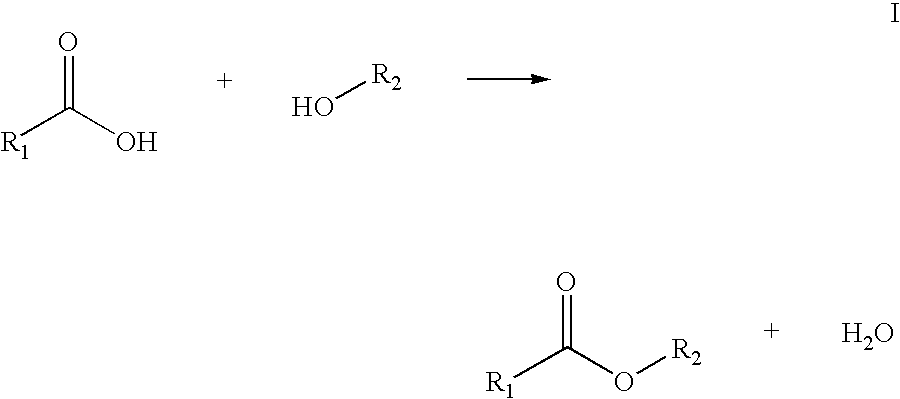Process for enzymatically preparing carboxylic esters
a technology of enzymatically preparing and carboxylic esters, which is applied in the field of enzymatically preparing carboxylic esters, can solve the problems of reduced reaction temperature, reduced particle size, and reduced activity loss
- Summary
- Abstract
- Description
- Claims
- Application Information
AI Technical Summary
Benefits of technology
Problems solved by technology
Method used
Image
Examples
example 1
Noninventive
Synthesis of Myristyl Myristate in a Stirred Flask
[0071]329 g of myristyl alcohol and 351 g of myristic acid were heated to 60° C. in a 1 L initial charge vessel and mixed by means of a magnetic stirrer. 2.72 g of Novozym 435 were added and the water of reaction formed was removed by applying a vacuum of 5 mbar, and the water was distilled off. The course of the reaction was monitored for ˜24 h by means of acid number titration (cf. Table 1).
TABLE 1Conversion data for Example 1:Time [min]Conversion [%]00.0%6043.9%12271.1%18093.0%35595.1%64098.0%80299.0%107999.4%144099.6%
example 2
Noninventive
Synthesis of Myristyl Myristate in a Fixed Bed Reactor—Expensively Modified Falling-Film Process for Removing the Water of Reaction
[0072]502 g of myristyl alcohol and 513 g of myristic acid were heated to 60° C. in a 2 l 5-neck flask with bottom outlet and mixed with a mechanical stirrer. 4.06 g of Novozym 435 were charged into a fixed bed heated to 60° C. (height 2 cm, diameter 3 cm). Subsequently, the reaction mixture was pumped with a gear pump through the enzyme-laden fixed bed in circulation via stainless steel tubes heated to 60° C. and back into the flask; the flow rate was set to 50 ml*min−1. To remove the water of reaction, a vacuum of 5 mbar was applied and the water was distilled off. To accelerate the removal of water, the reaction mixture, on re-entry into the flask, was allowed to flow down over a distance of about 15 cm in a thin film on the inner wall of a glass column heated to 60° C. The course of the reaction was monitored for ˜14 h by means of acid nu...
example 3
Inventive
Synthesis of Myristyl Myristate with Discharge of Water by Sparging
[0073]11 010 g of myristyl alcohol and 11 500 g of myristic acid were heated to 60° C. in a glass vessel heated to 60° with an internal diameter of 300 mm and a height of 700 mm. Through a ring sparger mounted at the bottom of the vessel, 5 m3 / h of nitrogen were introduced into the mixture. 90 g of Novozym 435 were added and the course of the reaction was monitored for ˜6 h by means of acid number titration (cf. Table 3).
TABLE 3Conversion data for Example 3:Time [min]Conversion [%]00.0%6067.0%12092.0%18096.9%24098.8%30099.5%36099.7%
PUM
| Property | Measurement | Unit |
|---|---|---|
| mean particle size | aaaaa | aaaaa |
| temperature | aaaaa | aaaaa |
| temperatures | aaaaa | aaaaa |
Abstract
Description
Claims
Application Information
 Login to View More
Login to View More - R&D
- Intellectual Property
- Life Sciences
- Materials
- Tech Scout
- Unparalleled Data Quality
- Higher Quality Content
- 60% Fewer Hallucinations
Browse by: Latest US Patents, China's latest patents, Technical Efficacy Thesaurus, Application Domain, Technology Topic, Popular Technical Reports.
© 2025 PatSnap. All rights reserved.Legal|Privacy policy|Modern Slavery Act Transparency Statement|Sitemap|About US| Contact US: help@patsnap.com



